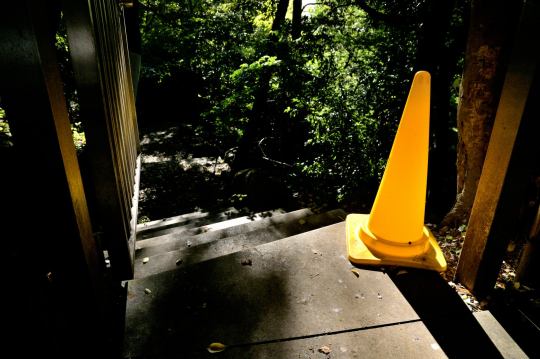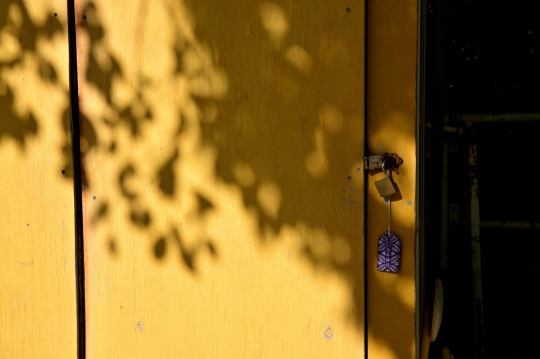#color:黄色
Explore tagged Tumblr posts
Photo

✿ 東京ばな奈 | Tokyo Banana
#tokyo banana#banana#sweets#東京ばな奈#sweets:バナナ#sweets:日本#日本#日本:バナナ#日本:東京#東京#東京:バナナ#東京バナナ#バナナ#東京ばな奈ワールド#品:日本#品:バナナ#品:東京#2020〜#color:黄色
33 notes
·
View notes
Text

🍏🍀 green soda trinket charm • 。・ 。 • ☆
#⠀˚‧ ゚ 。゚ ۪ ࣪🎀🥬 ⊹︵︵︵ ⊹ ୨🎀🌈୧ ⊹ ︵︵︵ ⊹ 🎀🥬˚‧ ゚ 。゚#🥞🎀 . ˚ ✦ ✿ . ˚ . ˚ ✿. ˚ 🥞🎀 . ˚✦ . ✿ ˚ 🥞🎀 * ˚ 🥞🎀 ✦ ˚ .#˚ .🧇🎀🌈 (🎀 ๑ ω ๑)ノ⌒*:・゚✧:*:・゚☆🍋🌺青 。・:*:・゚★黄色⭐️🌈絵の具₊˚𓇼 🍮🎀#★ ₊ . ° . ⋆° .🌈🎀🥕(*・ω・)Princess⋆˚✿˖°°🧃๋࣭🍊多彩な☘️🎀✿(*´◕ω◕`*)+✿.*🍓⭐🌈#⭐️🎀🍊.。*゚ .*.。( ๑´꒳`๑)。.。: *🍊🎀⭐️#かわいい#kawaii#aesthetic#otakucore#weebcore#webcore#animecore#neetcore#kawaiicore#toys#kawaii food#jojifuku#nijicore#pastel colors#pastelcore#cutecore#kawaii aesthetic
588 notes
·
View notes
Text

en dansent…
autumnal…

秋の音
かさかさと。。
46 notes
·
View notes
Text
ぷかぷかきてぃ〜(>。∂)☆彡


#⠀˚‧ ゚ 。゚ ۪ ࣪🎀🥬 ⊹︵︵︵ ⊹ ୨🎀🌈୧ ⊹ ︵︵︵ ⊹ 🎀🥬˚‧ ゚ 。゚#🥞🎀 . ˚ ✦ ✿ . ˚ . ˚ ✿. ˚ 🥞🎀 . ˚✦ . ✿ ˚ 🥞🎀 * ˚ 🥞🎀 ✦ ˚ .#˚ .🧇🎀🌈 (🎀 ๑ ω ๑)ノ⌒*:・゚✧:*:・゚☆🍋🌺青 。・:*:・゚★黄色⭐️🌈絵の具₊˚𓇼 🍮🎀#★ ₊ . ° . ⋆° .🌈🎀🥕(*・ω・)Princess⋆˚✿˖°°🧃๋࣭🍊多彩な☘️🎀✿(*´◕ω◕`*)+✿.*🍓⭐🌈#⭐️🎀🍊.。*゚ .*.。( ๑´꒳`๑)。.。: *🍊🎀⭐️#かわいい#otakucore#kawaii#aesthetic#weebcore#webcore#animecore#neetcore#00s#2000s#2000s core#plushies#hello kitty#sanrio#sanriocore#pastel colors#plush#🎀.sanrio
9 notes
·
View notes
Text




「黄/イエロー」
#yellow#color#nikoncreators#nikond300#photograph#photography#黄#黄色#キ#キイロ#色#色彩#写真#いつかの写真#写真好き#写真で伝えたい私の世界#写真好きな人と繋がりたい#歩楽里写真部
2 notes
·
View notes
Text
Okay okay catching up on Bleach because I was putting it off...
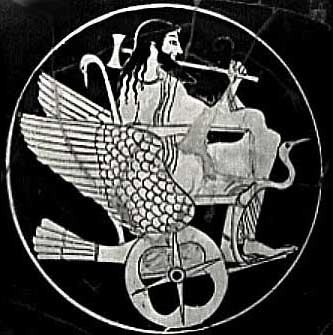

So the soul king has an actual name now and it's apparently Adnyeus(?*)[アドナイェウス] which at a glance I thought was some kind of weird mashup of Hebrew Adonai[אֲדֹנָי] and Latin deus as a kind of play on Yhwach's name being based on the tetragrammaton. But actually it's just the name Aidoneus[Ἀϊδωνεύς] which was an old epithet for the Greek Hades, supposedly meaning "The Unseen" which somewhat superficially fits for the Soul King as a king of the dead/underworld.
*(I have no idea where anyone is getting these romanizations I see flying around...)
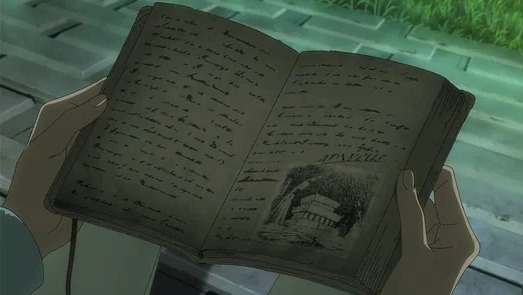

It's actually not the first time the name has come up. some eagle eyed fans caught that what appears to be "ADNYEUS" was shown back in episode 6 of TYBW in Ryuuken's notes, above the illustration of the castle Silbern. And then at the end of the previous season the anime added a chant to Yhwach's Auswählen that ran:
Kakageyo Gin no Monshou, Haiiro no Sougen, Hikari ni Uzumoreta, Enkan no Michi, Menou no Gankyu, Ougon no Shita, Zugai no Sakazuki, ADNYEUS no Hitsugi. Kakageru mono wa, Omae no Shinzou: AUSWÄHLEN [掲げよ 銀の紋章 灰色の草原 光に埋もれた円環の途 瑪瑙の眼球 黄金の舌 頭蓋の盃 アドナイェウスの棺 掲げるものは お前の心臓 聖別(アウスヴェーレン)] "Raise up Crest of Silver, Ash-colored(gray) Meadow, Circular Road hidden in (the) Light, Eye(s) of Agate, Tongue of Gold, Grail* of Skull, Coffin of Adnyeus. That which is Raised up is Your Heart: Auswählen."
*notably in one of Uryuu's German chants, the Japanese word for a [杯]:"sake cup" was paired with the German word Gral:"Grail", and [盃] and [杯] are alternate kanji for the same word. At the most literal the chant in Japanese just uses the word for "sake cup" like the one he uses for the schrift eucharist, but I feel like the more implicitly western imagery evoked by "skull Grail" or maybe "...chalice" is more in line with the ongoing aesthetic of Quincy spells
I'm not actually in a position to go doing a real deep dive on this but it does seem like at a glance there are associations with that alternate title with a specific incongruous variation of the god of the underworld--that is to say: characterizations of him under this epithets are not consistent with other more common interpretstions-- where he's actually got a lot of strong sun iconography. This of course maps almost perfectly with a bunch of stuff I've ranted on about a few different times in my Bleach ramblings.
Incidentally it is also the scientific namesake of the Papilio aidoneus... a black butterfly... In the first place Bleach's hell-butterflies were already a play on the real world association of butterflies and death, often either as psychopomps or themselves the souls of the dead. That they tie back in to the Soul King himself isn't too big a stretch.


As for this "triplet world" thing... We were already told that Hueco Mundo isn't actually it's own formal realm, it's the interstitial realm that just naturally exists in the space between one world and the next. So it kinda annoys me that this feels like it's really only being acknowledged because after the fact it's just where a big chunk of Bleach's plot happened, rather than actually being cosmologically on par with the other two.
Anyway the translations going around I notice are a little sloppy, mostly in that a few are clearly just machine translated and so ignored the use of Bleach specific terminology, like "reishi" and "kishi" so here's my quick breakdown of it (thank god it's short...)

原初の海から分かたれた尸魂界,現世, 虚圏の三つの世界。 The Three Worlds of Soul Society, This (the mortal) World, Hueco Mundo divided* from the Sea of Origin. 遍く魂魄の流れを司る礎であり, かつ世界の楔たる存在によって, The universal flow of spirits is the foundation to control, as well as the lynchpin of the world which is due to existence, 霊子の世界,器子の世界,砂の楽土の三世界が分離され, the Three Worlds of The World of Reishi, The World of Kishi, The Paradise of Sand are detached*, 『生』と『死』が隔てられた。 "Life" and "Death" were isolated*.
*so interestingly all three of these different words could be translated into english as "separated" but seem to be fairly distinct contextual differences: the first means like cutting one big thing up into smaller things the "A came from B" dynamic being the focus, the second means to be separated out almost like being categorized, and the third is to be isolated or alienated.

So first it's saying the three worlds came from one sea of origin, and that the flow of spirits between those three worlds is the key to existence being what it is, which is to say three distinct realms where death and life are these things that can never coexist. All of which is stuff we really already knew.

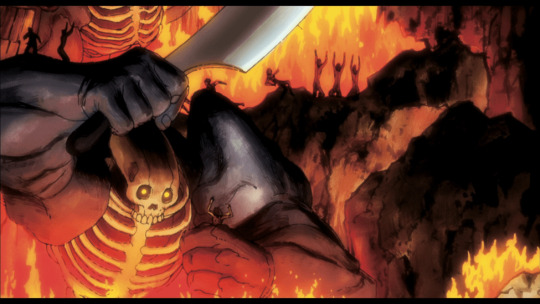
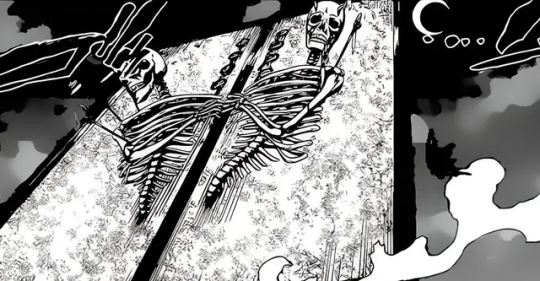
Also we're supposed to have just completely forgotten about Hell since it's not the current plot line, I guess? I anything the Three Worlds should be Soul Society, the Material World, and Hell, with Hueco Mundo as the interstitial void/aether, like it was originally defined as. That would at least map more sensibly onto the buddhist 3 realms of Form(Humans & animals: those bound by their physicality), Formless(Deva & Asura: those who exist in a hightened mental/spiritual state), and Desire(Preta & those in Hell: those defined by their strong need for what they lack)

Maybe that only real point of interest is the reference to Hueco Mundo as suna no rakudo[砂の楽土], a "paradise of sand." In this voice I think the idea is that if life and death being separate realms is a bad thing that Yhwach seeks to rectify, then by being an inbetween realm, Hueco Mundo is a paradise, because it's a place of neither life nor death? But if it is a place of rest and comfort then I wonder if that doesn't validate my thoughts on the Vastolorde being the natural path of development for a soul in reincarnation afterall?
That aside, this mostly just lines up with existing Buddhist/Hindu parallels that were always pretty obviously implied but not so directly touched on. Once again things I've babbled about in some form or another already... I'm not about to go digging them all up right now.
91 notes
·
View notes
Text
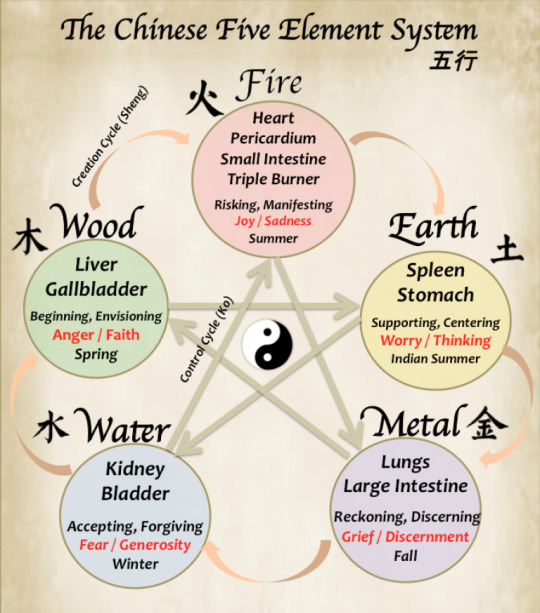
Legends of the humanoids
Reptilian humanoids (5)
Wuxing – the connections between the Five Dragon Kings (Ref) and the Five Elements philosophy
To better understand the origins of the Five Dragon Kings and the ancient Chinese legend, it is worth mentioning the wuxing of natural philosophy, which states that all things are composed of five elements: fire, water, wood, metal and earth.
The underlying idea is that the five elements 'influence each other, and that through their birth and death, heaven and earth change and circulate'.
The five elements are described as followed:
Wood/Spring: a period of growth, which generates abundant vitality, movement and wind.
Fire/Summer: a period of swelling, flowering, expanding with heat.
Earth is associated with ripening of grains in the yellow fields of late summer.
Metal/Autumn: a period of harvesting, collecting and dryness.
Water/Winter: a period of retreat, stillness, contracting and coolness.
The wuxing system, in use since the Han dynasty (2nd century BCE), appears in many seemingly disparate fields of early Chinese thought, including music, feng shui, alchemy, astrology, martial arts, military strategy, I Ching divination, and traditional medicine, serving as a metaphysics based on cosmic analogy.
The wuxing originally referred to the five major planets (Jupiter, Saturn, Mercury, Mars and Venus), which were thought of as the five forces that create life on earth. Wu Xing litterally means moving star and describes the five types of Qi (all the vital substances) cycles through various stages of transformation. As yin and yang continuously adjust to one another and transform into one another in a never-ending dance of harmony, they tend to do so in a predictable pattern.
The lists of correlations for the five elements are diverse, but there are two cycles explaining the major interaction. The yin-yang interaction, which by increasing or decreasing the qualities and functions associated with a particular phase, it may either nourish a phase that is in deficiency or drain a phase that is in excess or restrain a phase that is exerting too much influence (see below):
The Creation Cycle (Yang)
Wood feeds Fire
Fire creates Earth (ash)
Earth bears Metal
Metal collects Water
Water nourishes Wood
The Destruction Cycle (Yin)
Wood parts Earth
Earth dams (or absorbs) Water
Water extinguishes Fire
Fire melts Metal
Metal chops Wood
The Huainanzi (2nd BCE) describes the five colored dragons (azure/green, red, white, black, yellow) and their associations (Chapter 4: Terrestrial Forms), as well as the placement of sacred beasts in the five directions (the Four Symbols beasts, dragon, tiger, bird, tortoise in the four cardinal directions and the yellow dragon.
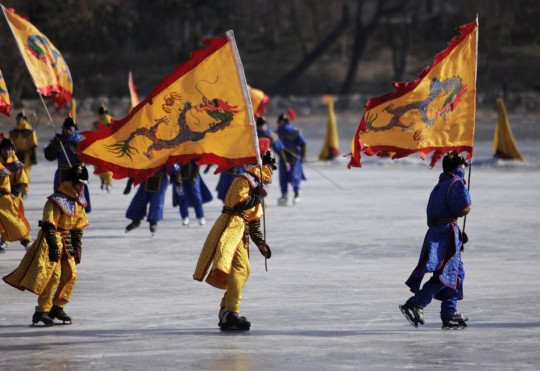
伝説のヒューマノイドたち
ヒト型爬虫類 (5)
五方龍王(参照)と五行思想の関連性
ここで、五方龍王の起源、そして古代中国の伝説をよく理解するために、万物は火・水・木・金・土の5種類の元素からなる、という自然哲学の五行思想について触れておきましょう。 5種類の元素は「互いに影響を与え合い、その生滅盛衰によって天地万物が変化し、循環する」という考えが根底に存在する。
五行は次のように説明されている:
木は、春の豊かな生命力、動き、風を生み出す成長期。
火は、夏の太陽の暖かさの下で行われる成熟の過程、熱で膨張する時期。
土は、晩夏の黄色い野原での穀物の成熟に関連している。
金は、秋の収穫、収集、乾燥の時期。
水は、冬の雪に覆われた暗い大地の中に潜む新しい生命の可能性と静寂の時期。 漢の時代 (紀元前2世紀頃) から使用されてきた五行説は、音楽、風水、錬金術、占星術、武術、軍事戦略、易経、伝統医学など、中国初期の思想の一見バラバラに見える多くの分野に登場し、宇宙の類推に基づく形而上学として機能している。
五行とは文字通り「動く星」を意味し、五種類の気(生命維持に必要なすべての物質)が様々な変容の段階を経て循環することを表している。陰と陽は絶え間なく互いに調整し合い、調和の終わりのないダンスで互いに変化していくため、予測可能なパターンで変化する傾向がある。
五行の相関関係は多様だが、主要な相互作用を説明する2つのサイクルがある。陰陽の相互作用は、特定の相に関連する資質や機能を増減させることで、不足している相に栄養を与えたり、過剰な相を排出したり、影響力を及ぼしすぎている相を抑制したりする (以下参照):
相生(陽)のサイクル
木は燃えて火を生む
火が土 (灰) をつくる
土は金属を産出する
金属は表面に水を集める
水は木を育てる
相克(陰)のサイクル
木は大地を構成する
土は水を堰き止める
水は火を消す
火は金属を溶かす
金属が木を切る
『淮南子』(紀元前2世紀)には、五色の龍(紺碧・緑、赤、白、黒、黄)とその関連性 (第4章: 地の形)、五方位への聖獣の配置(四枢の四象徴獣、龍、虎、鳥、亀、黄龍)が記述されている。
#wuxing#5 dragon kings#5 elements#taoism#yin yang#humanoids#legendary creatures#hybrids#hybrid beasts#cryptids#therianthropy#legend#mythology#folklore#dragon#nature#art
140 notes
·
View notes
Text
One Day - Lyrics + Translation

Please do not repost/retranslate without permission.
Kanji:
【All】 「おはよう」そして「おやすみ」を
生まれてきてくれて 有難う
これからもずっと傍に…
【Ei】 月にエスコートされて太陽は
【Sh】 空を目映く照らし出す
【Ki】 小鳥のさえずりを伴奏に
【Ei・Ki・Sh】 「いってらっしゃい」を愛で語ろう
【Ng】 街の賑やかさが
【Va】 高揚感を連れ出して
【Ng・Va】 今日も笑顔が咲いてゆく
【Ya】 後悔と反省は
【Ej】 暗くなる前に
【Ej・Ya】 手を繋ぎ合って
【Ng・Va】 希望と勇気に
【Ej・Ya】 変えてゆこうよ
【All】 幸せが「おかえり」って花ひらくから
【All】 一日の始まりから終わりまで
共に廻る 色とりどりの景色
どんな日々も (La la la)
一緒ならば (La la la)
いつだってアニバーサリー (アニバーサリー)
365日 そしてその先へ 丁寧に重ねてゆこう
【Ei】 四季折々のフェスティバルや
【Sh】 尊き誕生日はもちろん
【Ki】 ありふれた毎日の中さえ
【Ei・Ki・Sh】 奇跡は起こってゆくものだから
【Ng】 遊びだって 何だって
【Va】 手加減ナシの本気モード
【Ng・Va】 今日もついつい夜更かしさ
【Ya】 たまにするケンカは
【Ej】 信頼の証
【Ej・Ya】 喜怒哀楽が
【Ng・Va】 織り成していった
【Ej・Ya】 トクベツが ほら
【All】 日に日に かけがえのない場所になるんだ
【All】 うたた寝に温かなブランケット
揃いのカップ 涙に甘いカフェオレ
共に過ごす (La la la)
日常ぜんぶ (La la la)
羽ばたいたアニバーサリー (アニバーサリー)
365日 ひとつひとつから 愛を教わったんだよ
【Ei】 暁が高らかに 世界の
【Sh】 誕生に舞い 黎明は唄う
【Ki】 Morningの瑞々しさが育みを
【Ng】 Middayの輝きが 営みを
【Va】 黄昏は 喜び叫んでく
【Ya】 そしてオウマガトキ 抱きしめ合うように
【Ej】 互いを大切に想う 宵闇
【All】 空が移ろうたび 降り注ぐ祝福…
【All】 共鳴する夢と 感謝の歌を
最初からひとつだった魂
名前を付けよう (La la la)
この瞬間を (La la la)
美しきアニバーサリー (アニバーサリー)
365日 そしてその先へ 丁寧に重ねてゆこう
【All】 「おはよう」そして「おやすみ」を
命の限り 贈り続けよう
いつの日も「愛してる」を
Rōmaji:
【All】 “Ohayō” soshite “oyasumi” o
Umarete kite kurete arigatou
Korekara mo zutto soba ni…
【Ei】 Tsuki ni esukōto sarete taiyō wa
【Sh】 Sora o mabayuku terashi dasu
【Ki】 Kotori no saezuri o bansō ni
【Ei・Ki・Sh】 “Itterasshai” o ai de katarou
【Ng】 Machi no nigiyaka-sa ga
【Va】 Kōyōkan o tsuredashite
【Ng・Va】 Kyō mo egao ga saite yuku
【Ya】 Kōkai to hansei wa
【Ej】 Kuraku naru mae ni
【Ej・Ya】 Te o tsunagi atte
【Ng・Va】 Kibō to yūki ni
【Ej・Ya】 Kaete yukou yo
【All】 Shiawase ga “okaeri” tte hanahiraku kara
【All】 Ichinichi no hajimari kara owari made
Tomo ni meguru irotoridori no keshiki
Don’na hibi mo (La la la)
Issho naraba (La la la)
Itsu datte anibāsarī (anibāsarī)
Sanbyaku rokujū go nichi soshite sonosaki e teinei ni kasanete yukou
【Ei】 Shikioriori no fesutibaru ya
【Sh】 Tōtoki tanjōbi wa mochiron
【Ki】 Arifureta mainichi no naka sae
【Ei・Ki・Sh】 Kiseki wa okotte yuku mono dakara
【Ng】 Asobi datte nan datte
【Va】 Tekagen nashi no honki mōdo
【Ng・Va】 Kyō mo tsuitsui yofukashi sa
【Ya】 Tama ni suru kenka wa
【Ej】 Shinrai no akashi
【Ej・Ya】 Kidoairaku ga
【Ng・Va】 Orinashiteitta
【Ej・Ya】 Tokubetsu ga hora
【All】 Hinihini kakegae no nai basho ni naru nda
【All】 Utatane ni atatakana buranketto
Soroi no kappu namida ni amai kafeore
Tomo ni sugosu (La la la)
Nichijō zenbu (La la la)
Habataita anibāsarī (anibāsarī)
Sanbyaku rokujū go nichi hitotsuhitotsu kara ai o osowatta nda yo
【Ei】 Akatsuki ga takaraka ni sekai no
【Sh】 Tanjō ni mai reimei wa utau
【Ki】 Morning no mizumizushi-sa ga hagukumi o
【Ng】 Midday no kagayaki ga itonami o
【Va】 Tasogare wa yorokobi sakendeku
【Ya】 Soshite oumagatoki dakishime au yō ni
【Ej】 Tagai o taisetsu ni omou yoiyami
【All】 Sora ga utsurō tabi furisosogu shukufuku…
【All】 Kyōmei suru yume to kansha no uta o
Saisho kara hitotsu datta tamashī
Namae o tsukeyou (La la la)
Kono shunkan o (La la la)
utsukushiki anibāsarī (anibāsarī)
Sanbyaku rokujū go nichi soshite sonosakihe teinei ni kasanete yukou
【All】 “Ohayō” soshite “oyasumi” o
inochi no kagiri okuri tsudzukeyou
itsu no hi mo “aishiteru” o
Translation:
【All】 “Good morning” and “Good night”
Thank you for being born
Please stay by my side forever...
【Ei】 Escorted by the moon, the sun
【Sh】 Begins to dazzlingly illuminate the sky
【Ki】 Accompanied by the chirping of birds,
【Ei・Ki・Sh】 Let’s lovingly tell each other “See you later”
【Ng】 The bustle of the city
【Va】 Brings forth a feeling of exhilaration
【Ng・Va】 Today, too, smiles will blossom
【Ya】 Before it gets dark,
【Ej】 Let’s turn any
【Ej・Ya】 Regrets and remorse
【Ng・Va】 Into hope and courage
【Ej・Ya】 By holding hands
【All】 Because happiness blooms with a “Welcome home”
【All】 From the beginning to the end of each day,
We cycle together through a world of colorful scenes
No matter what kind of days may come, (La la la)
As long as we’re together, (La la la)
It’s always an anniversary (Anniversary)
365 days, and beyond — let’s carefully add to them one by one
【Ei】 Not just in the seasonal festivals
【Sh】 And precious birthdays, but even
【Ki】 Within our ordinary days,
【Ei・Ki・Sh】 Miracles are always happening
【Ng】 Whether we’re playing or doing anything else,
【Va】 It’s always serious and wholehearted, no holding back
【Ng・Va】 Today, we ended up staying up late again
【Ya】 The occasional argument
【Ej】 Is a sign of trust
【Ej・Ya】 Joy, anger, grief and pleasure
【Ng・Va】 Have woven together
【Ej・Ya】 Creating something special, you see
【All】 Day by day, it becomes an irreplaceable place
【All】 A warm blanket for a nap,
Matching cups, sweet café au lait for your tears
All the everyday moments (La la la)
We share (La la la)
Become a soaring anniversary (Anniversary)
From each of those 365 days, we’ve learned about love
【Ei】 Dawn rises high, celebrating the birth
【Sh】 Of the world and daybreak sings
【Ki】 Morning’s freshness nurtures,
【Ng】 The brightness of midday is alive
【Va】 And dusk shouts for joy
【Ya】 Then, by twilight, we hold each other close
【Ej】 We cherish each other deeply at midnight
【All】 Each time the sky changes, blessings rain down upon us…
【All】 A song of similar dreams and gratitude
From the start, our souls have been one
Let’s give a name (La la la)
To this moment (La la la)
A beautiful anniversary (Anniversary)
365 days, and beyond — let’s carefully add to them one by one
【All】 “Good morning” and “Good night”
For the rest of our lives, let’s keep exchanging these words
Everyday, let’s say “I love you”
#uta no prince sama#utapri#translation#english#he★vens#heavens#eiichi otori#kira sumeragi#nagi mikado#eiji otori#van kiryuin#yamato hyuga#shion amakusa#one day#lyrics
27 notes
·
View notes
Text
黄色のハイビスカス、沖縄らしいハイビスカスは真っ赤な花を咲かせるイメージですが、黄色やピンクなど様々なタイプがあります。形が異なるものもあって、よく見ると楽しいものです。写真は無料でダウンロードできるようにしていますので自由に利用してください。
Although hibiscus flowers are often imagined to be bright red, they come in various colors such as yellow and pink. There are also different shapes, making them enjoyable to observe closely. Feel free to download and use the photos for free.
27 notes
·
View notes
Text
Traditional Kimono Colors
This could be useful when creating art and deciding what colors to paint their kimono. For example, during certain eras in the past, some colors known as kinjiki can only be used by high ranking officials, while other colors known as yurushiiro are used by commoners. Ordinary people were forbidden to wear bright clothes by the order of the Edo shogunate, so people used to wear kimono in brown, grey or blue colors.
Different colors also had different associations. In the Edo period, asagi blue (the color of the Shinsengumi uniform) was associated with low-ranking countryside samurai, so the Shinsengumi members weren’t satisfied with their uniform.
In the Imperial Court, different colors denoted different ranks.

Geisha also had rules about what color combinations should be worn in each month. Their kimono would change to suit the season like so:
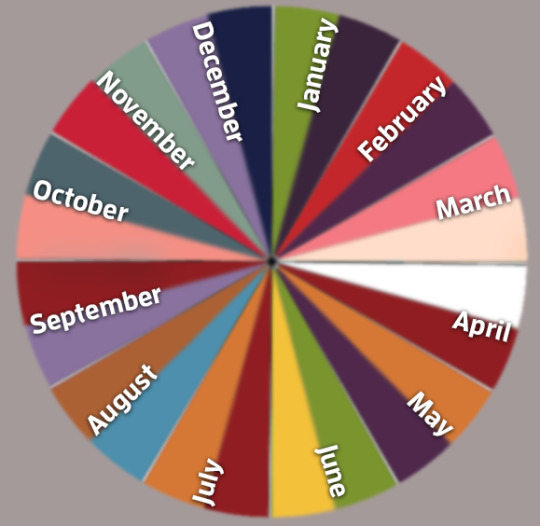
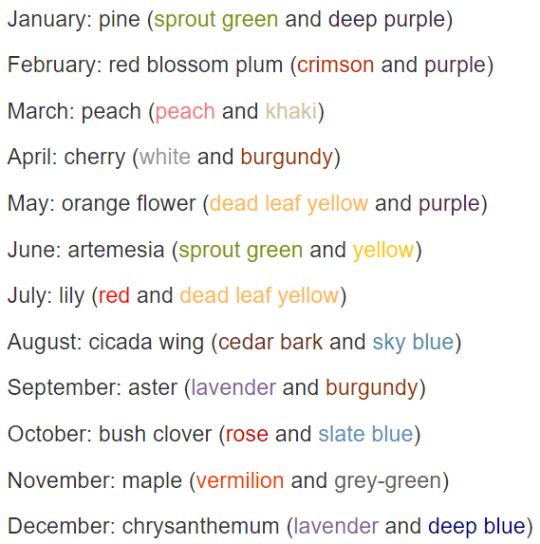
image source
The Japanese have developed their own collection of traditional colors, known as dentoushoku. The four core colors are white, black, red and blue. The names for these were mentioned earliest in historical texts and they have the most meanings attached to them. Only these four could be considered pure primary colors. (source)
According to this chart, the colors are often named after nature and are traditionally grouped into series. They look more muted than modern colors because they’re based on ancient dyeing techniques. These colors are commonly used in daily life: (桜色(Sakura iro), 桃色(momo iro), 薄紅(usubeni), 珊瑚色(sango iro), 小豆色(azuki iro), 玉子色(tamago iro), 橙色(daidai iro), 萌黄(moegi), 空色(sora iro)), while others are only mentioned in literature and used for kimono (source)

This site contains explanations of the names and history for a long list of traditional Japanese colors.
This site also contains a large list of colors with categories, such as Kimono colors, Edo Period colors, Japanese Painting and Ukiyo-e colors
For an immensely detailed and well-illustrated document of Japan’s old colors and their associated names, it’s worth visiting the beautiful website Nippon Colors.
[Edit] The Aizu Domain had its own color rank system for samurai and ashigaru (footsoldiers).
Upper rank (joshi) haori cord colors:
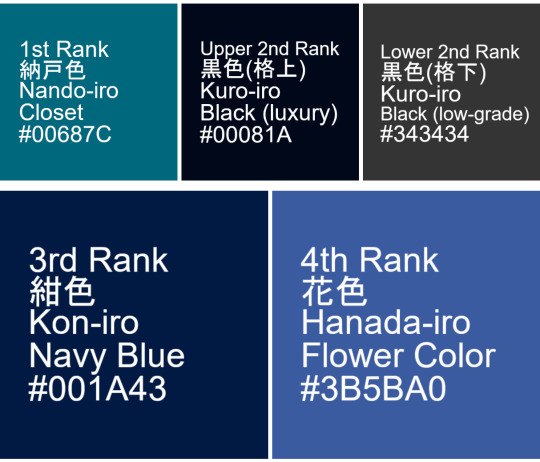
Middle rank (chushi) haori cord colors:
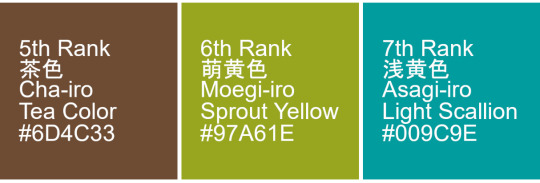
Lower rank (ashigaru) collar colors:
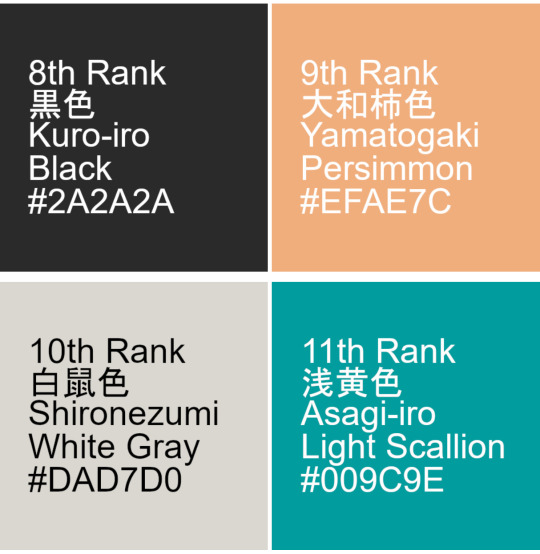
Reference
http://www.studio-mana.com/ippuku/dentousyoku/dentousyoku_shikisou.html
http://wagara.blogspot.com/p/traditional-colors.html
https://en.wikipedia.org/wiki/Traditional_colors_of_Japan
https://www.color-sample.com/popular/jiscolor/ja/
https://www.colordic.org/w
https://www.rakuten.ne.jp/gold/marutomo/value/color/
http://nipponcolors.com/
https://irocore.com/
http://www.fan.hi-ho.ne.jp/gary/aizumibun.htm
208 notes
·
View notes
Text
童謡
どうよう
children's song; nursery rhyme
紅葉(もみじ)Autumn Leaves - a popular nursery rhyme
Japanese
秋の夕日に akino yuu hini 照る山紅葉 teruyama momiji 濃いも薄いも koimo usuimo 数���る中に kazuaru nakani 松をいろどる matsuwo irodoru 楓や蔦は kaede ya tsuta wa 山のふもとの yamano fumotono 裾模様 suso moyhou
渓の流に tanino nagareni 散り浮く紅葉 chiriuku momiji 波にゆられて namini yurarete 離れて寄って hanarete yotte 赤や黄色の aka ya kiiro no 色さまざまに iro sama zamani 水の上にも mizu no uenimo 織る錦 oru nishiki
English
In the autumn sunset The autumn leaves shine bright Some are richer than others There are many shades of colors The pine trees are adorned With the maple and ivy leaves At the foot of the mountain They make a beautiful pattern
Down the mountain stream Fallen autumn leaves float Moving to and fro on the ripples Going apart and coming together They shine in red and gold Or many shades of them Drifting away on the water They weave a splendid brocade

#日本語#japanese#japanese language#japanese langblr#langblr#studyblr#単語#語彙#japanese vocabulary#童謡#japanese nursery rhymes#tokidokitokyo#tdtstudy
119 notes
·
View notes
Photo
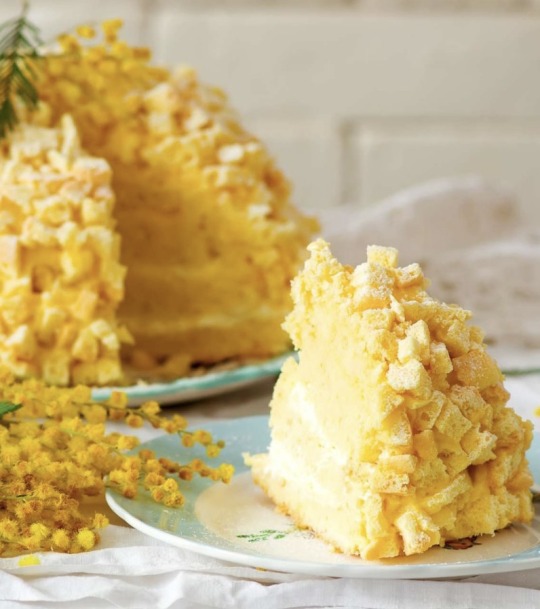
✿ トルタミモザ | Torta Mimosa ・ミモザの花に見立てたイタリアのケーキ。クリームとスポンジの層になったケーキで、表面は角切りまたは粉状にされたスポンジに覆われています。3月8日は、政治や社会においてジェンダー平等の実現を目指す国際的な記念日 「国際女性の日」ですが、イタリアでは「ミモザの日」と呼ばれています。 この日にはトルタミモザを食べたり、女性ヘミモザの花束を贈ったりする習慣があります。
#トルタミモザ#トルタ・ミモザ#ミモザケーキ#sweets:イタリア#イタリア:ケーキ#イタリア:ミモザ#ミモザ#イタリア#sweets#sweets:ケーキ#ケーキ#color:黄色#3月8日#season:3月#トルタ#ミモザの日#国際女性の日
3 notes
·
View notes
Text


🌈🎀⭐リンダキティ🌈🎀⭐
#⠀˚‧ ゚ 。゚ ۪ ࣪🎀🥬 ⊹︵︵︵ ⊹ ୨🎀🌈୧ ⊹ ︵︵︵ ⊹ 🎀🥬˚‧ ゚ 。゚#🥞🎀 . ˚ ✦ ✿ . ˚ . ˚ ✿. ˚ 🥞🎀 . ˚✦ . ✿ ˚ 🥞🎀 * ˚ 🥞🎀 ✦ ˚ .#˚ .🧇🎀🌈 (🎀 ๑ ω ๑)ノ⌒*:・゚✧:*:・゚☆🍋🌺青 。・:*:・゚★黄色⭐️🌈絵の具₊˚𓇼 🍮🎀#★ ₊ . ° . ⋆° .🌈🎀🥕(*・ω・)Princess⋆˚✿˖°°🧃๋࣭🍊多彩な☘️🎀#⭐️🎀🍊.。*゚ .*.。( ๑´꒳`๑)。.。: *🍊🎀⭐️#hello kitty#キティ・ホワイト#ハロー・キティ#kawaii#otakucore#animecore#kawaiicore#moecore#可愛い#かわいい#webcore#neetcore#weebcore#aesthetic#pinkcore#sanrio#sanriocore#sanrio aesthetic#jojifuku#pnikcore#happycore#colorful
562 notes
·
View notes
Text



秋田酒こまちを用いた新政二種飲み比べ(日本酒/生成 2022 22CEC-05 木桶26+27号 & 亜麻猫 2022 22PAN-05 木桶22号)・黄色きのこさん付き、秋刀魚の塩焼き、自家栽培ゴーヤと人参のかき揚げ、ピーマンと茄子の肉味噌炒め、オクラとトマトのサラダ。
Two Kinds of Aramasa(Japanese Sake/Ecru & Amaneko) feat. Yellow Mushroom from Colorful Mushrooms & Grilled Sanma Fish Dinner - September 2023
Previous Post:
17 notes
·
View notes
Text

Kazusa-Nakano Station: A Nostalgic Encounter with the Isumi Line Carriage・昭和レトロの旅:上総中野駅といすみ線の350型の黄色い一両列車
Location: Otaki Town, Chiba Prefecture, Japan Timestamp: 13:48・2024/07/10
Fujifilm X100V with 5% diffusion filter ISO 320 for 1/320 sec. at ƒ/2.2 Pro Negative High film simulation
While exploring the quaint Kazusa-Nakano Station, I was delighted when a single yellow carriage of the Isumi Line rolled gently into the station, its vibrant colors contrasting beautifully against the lush green backdrop.
This particular train is an Izumi Model 350, a diesel railcar series introduced to the Isumi Line in 2013 and 2014. The 350 Series is a modern iteration inspired by the classic Kiha 52 series, first introduced to Japanese railways in 1958. These diesel railcars are powered by an in-line 6-cylinder, 355 PS diesel engine.
Listening to the hum of the trains idling diesel engine, memories of my first ride on a single carriage diesel train came flooding back. It was on the Sagami Line in the 1980s, an experience that left a lasting impression on me as most other trains I have ridden since have all been electrified.
Check out my full write-up (1-minute read) at https://www.pix4japan.com/blog/20240710-carriage, where I dive into more details and provide sources for further reading and research.
#ストリートスナップ#千葉県#いすみ鉄道#上総中野駅#いすみ350形#pix4japan#FujifilmX100V#street photography#Japan#chiba prefecture#Kazusa-Nakano Station
16 notes
·
View notes
